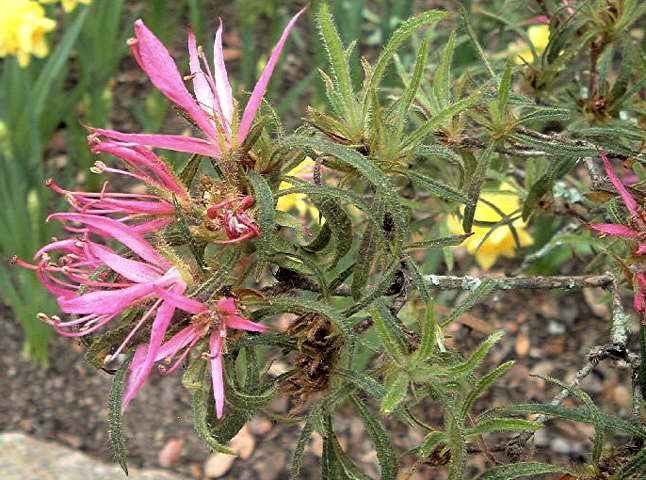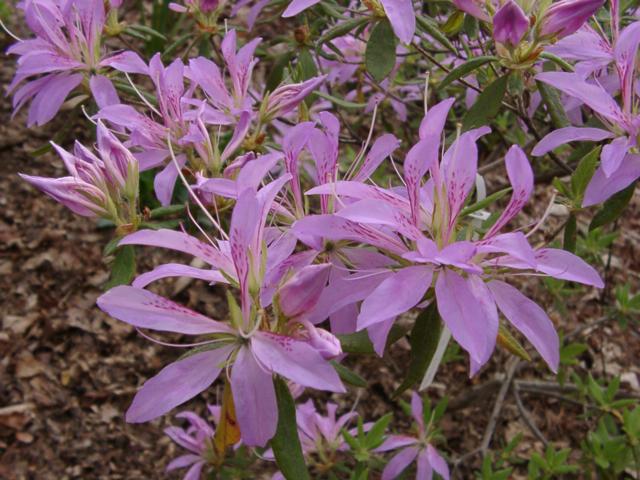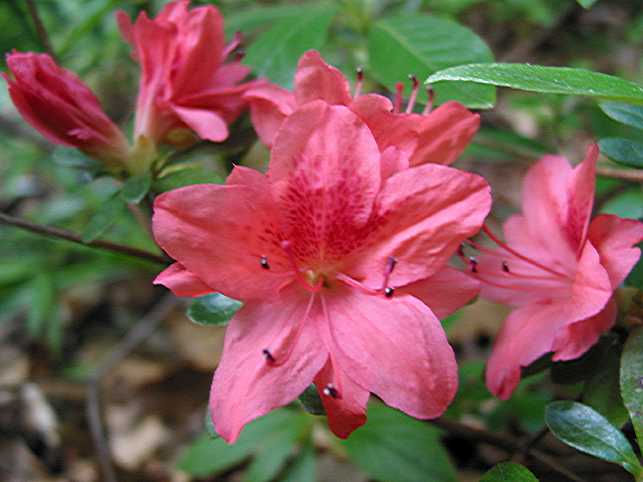Azaleas belong to the genus Rhododendron, with evergreen azaleas in the subgenus Tsutsusi and deciduous azaleas in the subgenus Pentanthera. Use this website to learn about azaleas–how to select and plant them, their needs and environmental requirements, and about the varieties available.
Some small-leaved rhododendrons look like evergreen azaleas. To tell them apart, first look at a flower—most azaleas have only 5 or 6 stamens, while most rhododendrons have 10 stamens.
Azalea Variability
Azaleas are either species or hybrids. A species is a population that interbreeds and is reproductively isolated from other populations. Seedlings from such isolated species populations look like the parents, or “grow true from seed”. Hybrids are registered crosses between other species or hybrids. Hybrids will not grow true from seed and may be faithfully reproduced only from cuttings, which are clones of the mother plant.
Azaleas have been hybridized for hundreds of years. Over 10,000 different azalea plants have been registered or named, although far fewer are in the trade. This provides a very wide variety of plant habits, sizes, colors and bloom times to meet almost every landscaping need or personal preference.
North American Species
All North American species azaleas, also called native azaleas, are deciduous (drop their leaves in the fall), with flower colors ranging from white to purple, pink, red, orange and yellow. Evergreen azaleas, native primarily to Japan, have flower colors including white and various shades of purple, pink, red and reddish orange, but not yellow. Color patterns include single colors and bicolors as well as sectors, stripes and flecks. For many azalea varieties, all the flowers on the plant are similar. For other varieties, the flowers on the plant may be a mixture of color variations, with a different mixture from one year to the next.
| There are many different flower types. They may be- single—a small green calyx at the base, 5 (rarely 6) petals, 5 or more stamens and 1 pistil (‘Higasa’, ‘Kobai’). They can be- hose-in-hose—10 to 12 petals, due to the calyx becoming petals (‘Satin Robe’). Some are- double—a variable number of petals, due to some or all of the stamens becoming petals (‘Bob Hill’). A very few are – double hose-in-hose—30 or more petals (‘Balsaminiflorum’). | ‘Bob Hill’ | ‘Balsaminiflorum’ |
| Different varieties also have different petal shapes, ranging from narrow petals (‘Linearifolium’, ‘Koromo Shikibu’) through triangular petals (‘Satin Robe’) to overlapping rounded petals (‘Kobai’). Petal edges may be flat, recurved, wavy or ruffled. | ‘Linearifolium’ | ‘Koromo Shikibu’ | ‘Kobai’ |
Plant Habits
Plant habits of different varieties of azaleas range from stiffly upright (many deciduous varieties), to broad spreading (many evergreen varieties), to irregular. While plant height is around 3 to 6 feet for many varieties, it ranges from under a foot to well over 15 feet for some varieties. A few evergreen varieties (‘Pink Cascade’) are weeping and may be grown as a hanging basket. Many varieties are dense and compact, Others are quite open, and some are almost tree-like.
Blooms
Most azalea varieties bloom in mid-April to mid-May in the mid-Atlantic area of the United States. A few varieties bloom a month or so earlier, and a few varieties bloom as late as August and September. Blooms typically last for one or two weeks. In warm climates such as the deep south of the United States, some azalea varieties bloom again in the fall. This re-blooming trait is being bred into the Encore™ azaleas for reliable fall blooming in colder areas as well.








